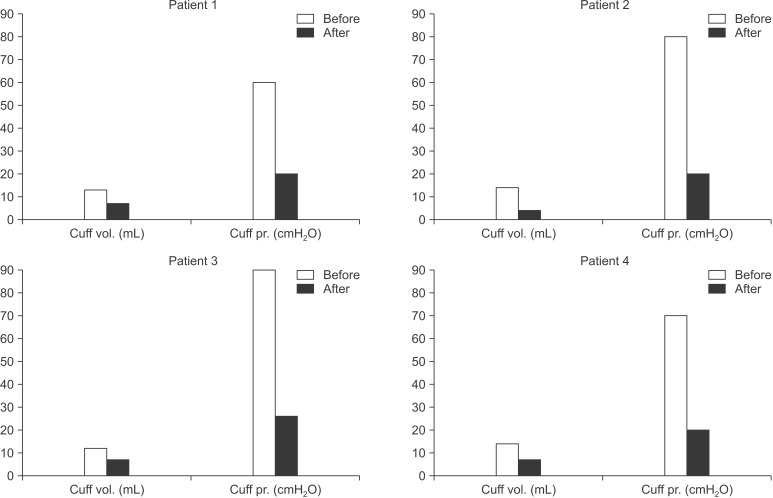Ann Rehabil Med.
2015 Dec;39(6):964-970. 10.5535/arm.2015.39.6.964.
Care Status of the ALS Patients With Long-Term Use of Tracheostomy Tube
- Affiliations
-
- 1Department of Rehabilitation Medicine, Pusan National University Hospital, Pusan National University School of Medicine, Busan, Korea. yi0314@gmail.com
- KMID: 2165623
- DOI: http://doi.org/10.5535/arm.2015.39.6.964
Abstract
OBJECTIVE
To evaluate the care status of the amyotrophic lateral sclerosis (ALS) patients with long-term use of tracheostomy tube by caregivers of ALS patients.
METHODS
A survey was conducted in the form of questionnaires to ALS patients and their caregivers. All measurements were performed by two visiting nurses. For statistical analysis, SPSS ver. 22.0 and Mann-Whitney U test on non-normal distribution were used.
RESULTS
In total, 19 patients (15 males and 4 females) and their caregivers participated in the survey. In the case of patients, the average duration of care was 5.9+/-3.7 years, and the mean periods of illness and tracheostomy were 5.3+/-3.2 years and 3.0+/-2.6 years, respectively. Replacement intervals were 14 days in 11 patients, 7 days in 4 patients, 28 days in 2 patients, and 21 days in 1 patient. One patient was unable to provide an accurate replacement interval. Eighteen (99%) caregivers had experience of adding volume to a cuff without pressure measure in the following instances: due to patients' needs in 7 cases, air leakage in 7 cases, and no reason in 4 cases. Mean pressure of tracheostomy cuff was 40+/-9.4 cmH2O, and air volume of tracheostomy cuff was 6.7+/-3.2 mL, but real mean volume was 7.0+/-2.9 mL. The number of suctioning for airway clearance was a mean 27.5+/-18.2 times a day.
CONCLUSION
According to this survey, we notice that almost all the patients and caregivers had an erroneous idea about cuff volume and pressure. Moreover, education and long-term professional care of tracheostomy cannot be overemphasized in this manner.
MeSH Terms
Figure
Cited by 1 articles
-
What is the Adequate Cuff Volume for Tracheostomy Tube? A Pilot Cadaver Study
Dong Min Kim, Myung Jun Shin, Sung Dong Kim, Yong Beom Shin, Ho Eun Park, Young Mo Kim, Jin A Yoon
Ann Rehabil Med. 2020;44(5):402-408. doi: 10.5535/arm.19210.
Reference
-
1. Chio A, Calvo A, Ghiglione P, Mazzini L, Mutani R, Mora G, et al. Tracheostomy in amyotrophic lateral sclerosis: a 10-year population-based study in Italy. J Neurol Neurosurg Psychiatry. 2010; 81:1141–1143. PMID: 20660920.
Article2. Escarrabill J, Estopa R, Farrero E, Monasterio C, Manresa F. Long-term mechanical ventilation in amyotrophic lateral sclerosis. Respir Med. 1998; 92:438–441. PMID: 9692102.
Article3. Marchese S, Lo Coco D, Lo Coco A. Outcome and attitudes toward home tracheostomy ventilation of consecutive patients: a 10-year experience. Respir Med. 2008; 102:430–436. PMID: 18023334.
Article4. Morris LL, Whitmer A, McIntosh E. Tracheostomy care and complications in the intensive care unit. Crit Care Nurse. 2013; 33:18–30. PMID: 24085825.
Article5. Hess DR. Tracheostomy tubes and related appliances. Respir Care. 2005; 50:497–510. PMID: 15807912.6. Sengupta P, Sessler DI, Maglinger P, Wells S, Vogt A, Durrani J, et al. Endotracheal tube cuff pressure in three hospitals, and the volume required to produce an appropriate cuff pressure. BMC Anesthesiol. 2004; 4:8. PMID: 15569386.
Article7. American Association for Respiratory Care. Endotracheal suctioning of mechanically ventilated patients with artificial airways 2010. AARC Clinical Practice Guidelines. Respir Care. 2010; 55:758–764. PMID: 20507660.8. Kaub-Wittemer D, von Steinbuchel N, Wasner M, Laier-Groeneveld G, Borasio GD. Quality of life and psychosocial issues in ventilated patients with amyotrophic lateral sclerosis and their caregivers. J Pain Symptom Manag. 2003; 26:890–896.
Article9. Rabkin JG, Albert SM, Tider T, Del Bene ML, O'Sullivan I, Rowland LP, et al. Predictors and course of elective long-term mechanical ventilation: a prospective study of ALS patients. Amyotroph Lateral Scler. 2006; 7:86–95. PMID: 16753972.
Article10. Regan K, Hunt K. Tracheostomy management. Contin Educ Anaesth Crit Care Pain. 2008; 8:31–35.
Article11. Yaremchuk K. Regular tracheostomy tube changes to prevent formation of granulation tissue. Laryngoscope. 2003; 113:1–10. PMID: 12514373.
Article12. Mallick A, Bodenham AR. Tracheostomy in critically ill patients. Eur J Anaesthesiol. 2010; 27:676–682. PMID: 20523214.
Article13. McGrath BA, Bates L, Atkinson D, Moore JA. National Tracheostomy Safety Project. Multidisciplinary guidelines for the management of tracheostomy and laryngectomy airway emergencies. Anaesthesia. 2012; 67:1025–1041. PMID: 22731935.
Article14. Byard RW, Gilbert JD. Potentially lethal complications of tracheostomy: autopsy considerations. Am J Forensic Med Pathol. 2011; 32:352–354. PMID: 21817868.15. Epstein SK. Late complications of tracheostomy. Respir Care. 2005; 50:542–549. PMID: 15807919.16. Sue RD, Susanto I. Long-term complications of artificial airways. Clin Chest Med. 2003; 24:457–471. PMID: 14535220.
Article17. Lewarski JS. Long-term care of the patient with a tracheostomy. Respir Care. 2005; 50:534–537. PMID: 15807917.
- Full Text Links
- Actions
-
Cited
- CITED
-
- Close
- Share
- Similar articles
-
- Review of the Various Tubes and Accessories Used for Pediatric Tracheostomy, and Changes in Physiology of Swallowing Associated with the Procedure
- Use of Speaking Tracheostomy Tube in the Long-term snd Chronic Ventilating Patient
- Successful Management of Acquired Tracheomalacia of Patients With Amyotrophic Lateral Sclerosis: A Report of Three Cases
- Application of an Automatic Suction Device to a Patient with A Tracheostomy Tube in the General Ward: A Case Report
- Factors Affecting Wound Healing after Decannulation of Tracheostomy Tube




